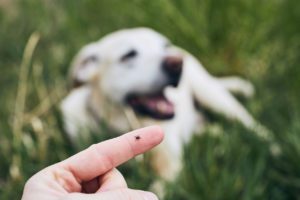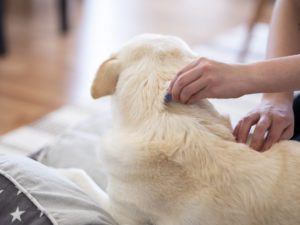How to Remove a Tick From a Dog in Lake City, FL
Knowing how to remove a tick safely and completely from your dog is essential for your dog’s health in Lake City. However, you may be missing vital information when it comes to ticks. Do you know there are seven hundred species of hard ticks and two hundred species of soft ticks? Are you aware of the significant four well-known ticks that bring diseases to your dog?
In this article, we will talk about safely removing a tick and a few myths of tick removal, those four disease-sharing species (some of the diseases you need to be aware of), what you should do with a removed tick (especially if you have concerns), and how to prevent your dog from getting ticks.

The Four Ticks You Need To Know
Lone Star Tick
Ticks attach to your dog by inserting their mouthparts (the capitulum), also often referred to as the head of the tick, into your dog’s skin. Many ticks also use a sticky, glue-like substance from their salivary glands to hold themselves firmly to your dog’s body. This is important because ticks like the Lone Star tick use this gluing technique to transmit viruses.
The Lone Star tick was once considered a tick of the south, today due to deforestation and animal migration; that is no longer true. You will find that is the case with all four of the ticks discussed here. To identify the Lone Star tick, you need to look for the spot that gives it the name. The females have a defined silver-colored area often described as a star shape on their outer shell. In contrast, males have a pale spot with a less recognizable form.
Lone Star ticks are known for their speed. They can cover a human leg in less than five minutes, a trait that makes it easier to identify the species. It is not unheard of to see up to a thousand or more ticks on a single leaf of a plant. Bites from the Lone Star tick will often leave a circular rash similar to the Lyme Disease Bullseye. However, they are not known carriers of Lyme Disease.
The American Dog Tick
The second tick you should know is the Dermacentor variabilis, also known as the American Dog tick. Even though they are present all year long, they are most noticeable in the spring of the year. The life cycle of the American Dog tick is dependent on the temperature and environment.
However, you need to know they can live up to five hundred and forty days without food, starting as larvae. In the nymph’s stage of their life cycle, they can go five hundred and eighty-four days without food, that’s more than a year and a half without a blood meal.
Adult ticks can live for up to two years without food. The adult American Dog tick is chestnut brown and will have white spots or streaks on their backs. An engorged female will turn a slate gray color, expanding in length around a half of an inch, dropping off once they are full.
Before she completes her life cycle, she will lay from four thousand to six thousand five hundred eggs. While the male American Dog tick will attach to your dog, alternately feeding and mating for an indefinite amount of time, it is also the unique thing about the American Dog tick species.
The Brown Dog Tick
The third tick is the most widespread tick globally and a well-recognized carrier of many viruses and diseases affecting dogs. However, the Rhipicephalus sanguineus, also known as the Brown Dog tick, has not been shown to transmit the bacterium that causes Lyme disease. They are better known for causing infestations worldwide.
The Brown Dog tick is unique because it can complete its life cycle outside, where we expect to find them, or indoors, where we do not expect them. Brown Dog tick infestations occur in residents, dog kennels, grooming facilities, and even veterinarian clinics. Dogs are their preferred host and appear necessary to maintain their large population.
Unfortunately, the Brown Dog tick infestations are often not noticed until they climb up the curtains. Eggs of this tick are spherical and dark brown, which can be spotted in nests in openings near wall hangings, ceilings, roofs, cracks around baseboards, window frames, and door frames. Each nest contains one thousand to three thousand eggs. Both the nymphs and adults look similar with a reddish-brown color and an elongated body shape.
The only difference is that the adults are larger. Female Brown Dog ticks will increase their body size by one hundred percent during feeding. It almost appears as if your dog has a raisin attached to them. The males and females of this tick species are difficult to identify without magnification. However, the males do not engorge as much as the females and take small blood meals before dropping off your dog.
The Black-Legged Tick
The fourth and final tick we need to know about is the Ixodes scapularis, the Black-legged tick, known even better by the name Deer tick. Yes, this tick is the carrier of one of the most feared tick diseases for all dog parents, Lyme Disease. The female Deer tick is about one-eighth of an inch in size, while the male is smaller, coming in around one-sixteenth of an inch.
The male Deer tick is reddish-brown, while the females are orangish-brown with black legs, mouthparts, and scutum (the shield). The unique trait of this dangerous tick is visible in the sharply pointed, toothed mouthparts.
Now that we know more about the four disease-sharing species of ticks, it’s essential that you safely and completely remove the tick from your dog’s body with a fine-tipped tweezer or a tick hook.

Safe Tick Removal Methods
Tools For Tick Removal
Before you can safely remove the tick from your dog, you will need a few things. A glove is highly recommended for the hand you may touch the tick with. The ticks found on your dog are disease carriers. Some of these diseases can affect you and your family. Rubbing alcohol to clean the bite site after removing the tick and a tick hook or tweezers.
Not just any pair of tweezers; you want to have a fine-tipped pair of tweezers to avoid tearing the tick and possibly spreading an infection to the bite area. Never remove a tick with your fingers. It could be very ineffective, and squeezing the tick may inject infectious material into your dog.
Calm Your Dog Down
Before removing the tick, the next critical thing you must do is make sure you and your dog are calm. If you are full of squeamish anxiety, your dog will notice, and you may even try to rush through this process, leaving the head behind. If this is the case, take a deep breath and know you are doing this to protect your dog, thousands of pet parents have done this before.
Your dog also has to be calm, so if they are running in circles at this moment and you want to get this tick off, relax (the tick most likely won’t move). Play a game you know wears them out, then join them with your supplies at their level or where you can have the best view and reach of the tick. Ticks don’t actually have heads, so their mouth part is inserted in your dog’s skin.
How to Remove The Tick Safely
Before you can pull the tick, you need to have a clear — or as precise as you can get a view. Carefully spread your dog’s hair away from the location of the tick. It’s a good idea to do this with your gloved hand to prevent the spread of tick-related diseases. There is a difference between using tweezers and a tick hook. You will want to have a pad or a pan under the area for collecting the tick when it falls off. Starting with the tweezers method, remember that the tweezers should be fine pointed.
First, grasp the tick as close to the skin as possible, then you want to pull, very gently, upward in one slow but steady motion. There are two types of tick hooks. In comparison, both are shaped to get under the body of the tick, also getting as close to the skin as possible where the mouth part is attached. One is designed for a slow, steady twisting motion.
Lifting as soon as you notice the tick has released. The second is intended to apply slow pressure. Once you have the hook in place, begin to put pressure on the tick. You do not want to put too much pressure on the tick’s abdomen because it could rupture, allowing the toxins to go back into the dog. Using this technique will take a few minutes. As you notice the head of the tick coming out, you will want to add more pressure gently.
After Removal
How do you know if you got all of the tick out of your dog? Always start looking for this answer in the tick. This is one of the reasons it is imperative to know where the tick lands and have a clear view of it. Often, if a tick’s head is left in your dog, the tick will no longer be alive.
So even though it may give you the heebeegeebees, to see that tick moving is a good sign that you have gotten all of the tick. What do you do if the mouthpart of the tick is still in your dog? Do not panic! Keep the hair out of the area as much as possible using the fine pointed tweezers you should be able to grab onto it and slowly pull the tick mouthpart out.
Another method for removing the head is to sterilize a needle, wash the area with some alcohol then carefully lift the head out. It may break into small pieces. That’s okay because the skin will slowly shed it. However, contact your vet immediately if the whole head is still in your dog and you cannot get it.
Always clean the area with alcohol to prevent infections. Before you dispose of the tick, you should be aware of some of the diseases ticks carry and can share with your dog. Rocky Mountain Spotted Fever, Tularemia, Canine Granulocytic Ehrlichiosis, Anaplasmosis, Babesiosis, and Lyme Disease are a few.
Dousing the tick with alcohol to kill it, placing it in a sealed bag or container keeping it for a few months is a good idea. You can also drop it off at your vet at your convenience. They will send it to the right scientists who can tell you if and what types of disease the tick is carrying.

Conclusion
It takes about seventy hours for a tick to become fully engorged on your dog. Check them over if you live in an area known for ticks, have been to a place where ticks are commonly found or have spotted one on yourself. Please check your dog’s toes because dogs do not spread their toes apart. Their toes are a common and often overlooked hiding spot.
There are a few more tick removal methods you should be aware of. Lighting a match then blowing it out, holding the hot sulphury smoke to the tick, slathering petroleum jelly on it, and waiting for the tick to fall off, drowning it in baking soda mixed with dish soap. You need to be very aware of these methods. Knowing this, one of the safest ways to keep ticks off your dog is using tick prevention treatments: drops, collars, injections, and ultrasonic repellents.
Always consult your vet if you have any concerns about a tick on your dog. Your vet understands how special your dog is to you and your family!

